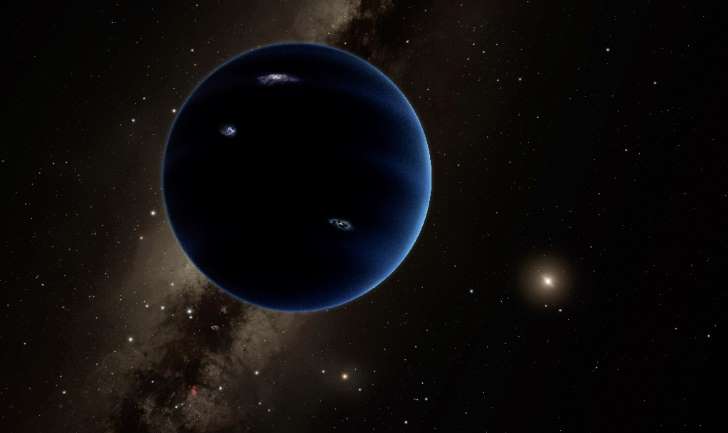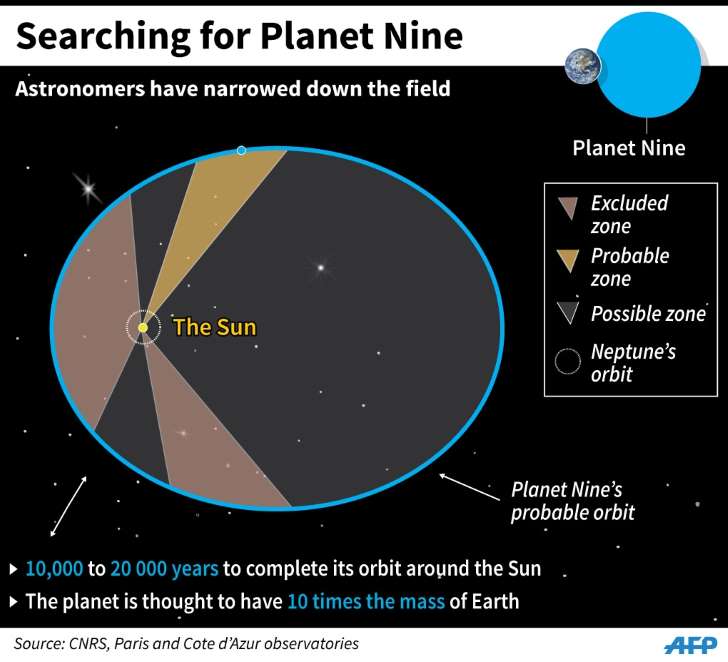February 23, 2016
US astronomers announced last month they may have found a ninth planet beyond Neptune, but conceded they had no idea where on an estimated 10,000-20,000-year orbit it might be.

This artist's concept illustration received January 20, 2016 courtesy of Caltech/Robert Hurt shows a distant view from Planet Nine back towards the sun
February 23, 2016
US astronomers announced last month they may have found a ninth planet beyond Neptune, but conceded they had no idea where on an estimated 10,000-20,000-year orbit it might be.

This artist's concept illustration received January 20, 2016 courtesy of Caltech/Robert Hurt shows a distant view from Planet Nine back towards the sun
On Tuesday, a French science quartet said they have narrowed the search area.
By studying data from NASA's Cassini spacecraft orbiting Saturn, the seventh planet from the Sun, they could exclude two zones, the team wrote in the journal Astronomy and Astrophysics.
Their work confirmed that a ninth planet might exist in the far reaches of our Solar System, co-author Jacques Laskar of the Paris Observatory told AFP, "but not just anywhere".
Based on mathematical modelling, the French scientists calculated what influence a ninth planet — travelling along the orbit postulated by the Americans — would have on the movement of other planets as it passed nearby.
They then looked at how the known planets actually behaved.
The postulated planet is thought to circle the Sun in a lopsided, highly elongated, oval loop.

Chart showing the zones where astronomers think the ninth planet in the Solar System is most likely to be found.
At its most distant from the Sun, the planet would be too far too away for any effect on other planets to ever be detectable, thus limiting astronomers to a searchable zone representing only about half of the total orbit.
Now Laskar and his team have reduced the search area by 50 percent by eliminating two zones in which they say the modelling does not match reality.
"We have cut the work in half," he told AFP.
Last month, astronomers Konstantin Batygin and Mike Brown predicted the existence of what they dubbed Planet Nine, about 10 times more massive than Earth.
Its existence was predicted with mathematical modelling and computer simulations, and was said to exactly explain the strange clumping behaviour of a group of dwarf planets in the Kuiper Belt, a field of icy objects and debris beyond Neptune.
Laskar and his team said the search field can be further narrowed if Cassini, due to finish its mission next year, is extended to 2020.
Astronomers expect it would take years to find Planet Nine, if it exists at all.
It would take a very large telescope to spot the planet at that distance, and with no clear idea of where on its very large orbit it is.
Many other planets have been predicted through modelling over the years, mostly wrongly.
In one famous case the science was right — the discovery of Neptune, first predicted from its gravitational pull on Uranus.
Courtesy: AFP







































































































